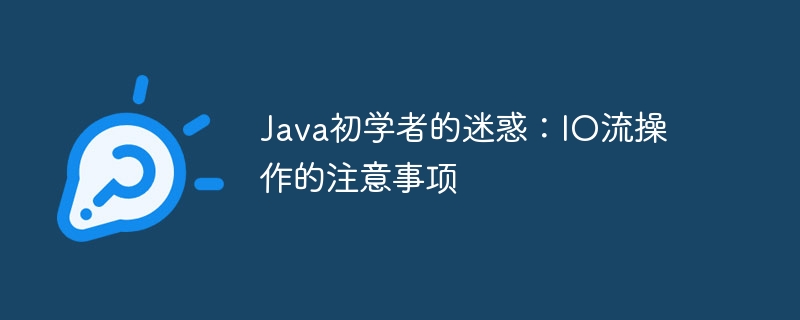Confusion for Java beginners: Precautions for IO stream operations
In IO stream operations, Java beginners need to pay attention to the following: the stream should be closed after reading or writing to release resources. Exception handling is very important for IO operations. Choose the correct stream type (character stream or byte stream). The following practical example shows how to read and write files: Reading a file: Use BufferedReader and FileReader to read the contents line by line from "file.txt". Writing to a file: Use BufferedWriter and FileWriter to write "Hello, world!" to "file.txt".

Things Java beginners need to pay attention to in IO stream operations
Introduction
For Java beginners, IO stream operations can be confusing, especially when file input and output are involved. This article aims to clarify these confusions by providing some considerations and practical examples.
Notes
- Close the stream: After a read or write operation is completed, always close the stream to release system resources.
- Exception handling: IO operations may throw exceptions, so proper exception handling is crucial.
- Character stream and byte stream: Java provides two types of streams: character stream (Reader/Writer) and byte stream (InputStream/OutputStream). Choosing the appropriate stream type is very important for correct processing of data.
Practical case
Read file
try (BufferedReader reader = new BufferedReader(new FileReader("file.txt"))) {
String line;
while ((line = reader.readLine()) != null) {
// 处理每一行
}
} catch (IOException e) {
e.printStackTrace();
}Write file
try (BufferedWriter writer = new BufferedWriter(new FileWriter("file.txt"))) {
writer.write("Hello, world!");
} catch (IOException e) {
e.printStackTrace();
}Note: In these cases, we use try-with-resources statements to ensure that the stream is closed properly at the end of the statement block.
Other Tips
- Using wrapper classes such as
ScannerandPrintWritercan simplify IO operations. - Consider using buffered streams to improve performance.
- Understand the stream hierarchy (FileInputStream -> BufferedInputStream -> DataInputStream) and stream modifiers (PushbackInputStream, FilterInputStream).
The above is the detailed content of Confusion for Java beginners: Precautions for IO stream operations. For more information, please follow other related articles on the PHP Chinese website!

Hot AI Tools

Undresser.AI Undress
AI-powered app for creating realistic nude photos

AI Clothes Remover
Online AI tool for removing clothes from photos.

Undress AI Tool
Undress images for free

Clothoff.io
AI clothes remover

AI Hentai Generator
Generate AI Hentai for free.

Hot Article

Hot Tools

Notepad++7.3.1
Easy-to-use and free code editor

SublimeText3 Chinese version
Chinese version, very easy to use

Zend Studio 13.0.1
Powerful PHP integrated development environment

Dreamweaver CS6
Visual web development tools

SublimeText3 Mac version
God-level code editing software (SublimeText3)

Hot Topics
 1376
1376
 52
52
 Square Root in Java
Aug 30, 2024 pm 04:26 PM
Square Root in Java
Aug 30, 2024 pm 04:26 PM
Guide to Square Root in Java. Here we discuss how Square Root works in Java with example and its code implementation respectively.
 Perfect Number in Java
Aug 30, 2024 pm 04:28 PM
Perfect Number in Java
Aug 30, 2024 pm 04:28 PM
Guide to Perfect Number in Java. Here we discuss the Definition, How to check Perfect number in Java?, examples with code implementation.
 Random Number Generator in Java
Aug 30, 2024 pm 04:27 PM
Random Number Generator in Java
Aug 30, 2024 pm 04:27 PM
Guide to Random Number Generator in Java. Here we discuss Functions in Java with examples and two different Generators with ther examples.
 Weka in Java
Aug 30, 2024 pm 04:28 PM
Weka in Java
Aug 30, 2024 pm 04:28 PM
Guide to Weka in Java. Here we discuss the Introduction, how to use weka java, the type of platform, and advantages with examples.
 Smith Number in Java
Aug 30, 2024 pm 04:28 PM
Smith Number in Java
Aug 30, 2024 pm 04:28 PM
Guide to Smith Number in Java. Here we discuss the Definition, How to check smith number in Java? example with code implementation.
 Java Spring Interview Questions
Aug 30, 2024 pm 04:29 PM
Java Spring Interview Questions
Aug 30, 2024 pm 04:29 PM
In this article, we have kept the most asked Java Spring Interview Questions with their detailed answers. So that you can crack the interview.
 Break or return from Java 8 stream forEach?
Feb 07, 2025 pm 12:09 PM
Break or return from Java 8 stream forEach?
Feb 07, 2025 pm 12:09 PM
Java 8 introduces the Stream API, providing a powerful and expressive way to process data collections. However, a common question when using Stream is: How to break or return from a forEach operation? Traditional loops allow for early interruption or return, but Stream's forEach method does not directly support this method. This article will explain the reasons and explore alternative methods for implementing premature termination in Stream processing systems. Further reading: Java Stream API improvements Understand Stream forEach The forEach method is a terminal operation that performs one operation on each element in the Stream. Its design intention is
 TimeStamp to Date in Java
Aug 30, 2024 pm 04:28 PM
TimeStamp to Date in Java
Aug 30, 2024 pm 04:28 PM
Guide to TimeStamp to Date in Java. Here we also discuss the introduction and how to convert timestamp to date in java along with examples.




